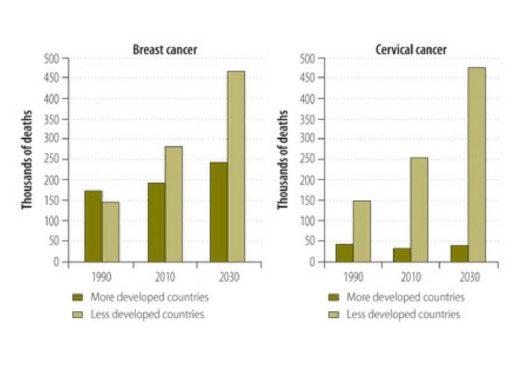Women in the U.S. will be less affected by the projected spike
 The population of Denmark is roughly 5.5 million people, and that’s how many women are expected to die worldwide from cancer by 2030 – a 60% increase from 3.5 million deaths in 2012.
The population of Denmark is roughly 5.5 million people, and that’s how many women are expected to die worldwide from cancer by 2030 – a 60% increase from 3.5 million deaths in 2012.
The sobering projection comes from a new report by the American Cancer Society (ACS) that was presented at the World Cancer Congress in Paris on November 1.
The World Health Organization (WHO) estimates that there were about 6.7 million new cancer cases in women worldwide in 2012. That number will likely rise to about 9.9 million new cases by 2030, according to the report.
When women in developing countries die from cancer, it is most often from breast, lung, and colorectal cancers. However, in less-developed countries, the deadliest forms of cancer for women are breast, cervical, and lung cancer.
Does Geographical Location Affect Survival Rates?
In 2012, the highest cancer rates were found in high-income countries, mainly due to better screening and detection. Denmark, the U.S., South Korea, the Netherlands, and Belgium had the highest number of cases.
Even so, the incidence of cancer and morality rates has dropped 20% in the U.S. since 1991. Sally Cowal, the author of the new report, attributes part of the decrease to better tobacco control and medical treatment.
The highest cancer rates are now found in Zimbabwe, Malawi, Kenya, Mongolia, and Papua New Guinea – poorer nations where there is less access to healthcare.
The report found that early detection and treatment played a vital role in breast cancer survival, and varied greatly between countries worldwide.
In high-income countries such as Canada, Australia, Israel, Brazil, and many northern and western European nations, the five-year survival rate from breast cancer was more than 85%. But survival was 60% or less for low- and middle-income countries such as South Africa, Mongolia, Algeria, and India.
Cowal said:
“It’s incumbent upon both the public and private sectors, as members of the global health community, to find ways to reduce the impacts of cancer on women by increasing prevention and treatment, saving the lives of women across the globe.”
Additionally, the report found that:
Breast cancer is the most commonly-diagnosed cancer in the world. The exceptions were China and North Korea, where there is a higher incidence of lung cancer. This is due to higher rates of smoking. In China, 50% of the men smoke compared to just 2% of the women. Lung cancer in Chinese women is likely the result of exposure to secondhand smoke and environmental pollution.
Cervical cancer was most prevalent in African nations. Cowal explained that people who are HIV-positive are five times more likely to have cervical cancer. She said that places in southern and eastern Africa, “with higher rates of HIV, also had higher rates of cervical cancer.”
 The Vicious Cycle
The Vicious Cycle
The introduction of a basic cancer control program, including preventative care and early diagnosis efforts, could help save lives in low- and middle-income countries, the Disease Control Priorities Group says; and such an effort would cost less than $2 per capita. [3]
If only it were that simple. It’s not.
The number of women’s cancer deaths isn’t expected to leap quite so high in the United States. The forecasted increase will affect mainly low- and middle-income countries. The women who live in these developing countries are living longer, but picking up risky habits like smoking and eating a poor diet as the economy improves.
Most of the cancer deaths in these countries are projected to occur among young and middle-aged adults, which would put a strain on the developing economies.
In 2009, the economic toll of women’s cancer was estimated to be about $286 billion, primarily due to the premature deaths of people in the work force.
In 2008, according to the report, in the U.S. alone, the “years of productive life lost due to cancer in women corresponded to $82 billion.”
The report goes on to say:
“To prevent cancer in the future, countries must prioritize policies to reduce known cancer risk factors and make prevention accessible to all. For those who have cancer today, effective treatments and palliative care are also needed.”
Written by Julie Fidler and published by the Natural Society ~ December 1, 2016.
FAIR USE NOTICE: This site contains copyrighted material the use of which has not always been specifically authorized by the copyright owner. We are making such material available in our efforts to advance understanding of environmental, political, human rights, economic, democracy, scientific, and social justice issues, etc. We believe this constitutes a ‘fair use’ of any such copyrighted material as provided for in section 107 of the US Copyright Law. In accordance with Title 17 U. S. C. Section 107, the material on this site is distributed without profit to those who have expressed a prior interest in receiving the included information for research and educational purposes. For more information go to: http://www.law.cornell.edu/uscode/17/107.shtml“
